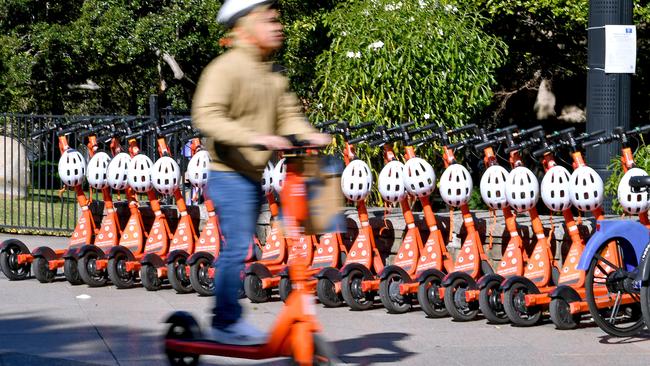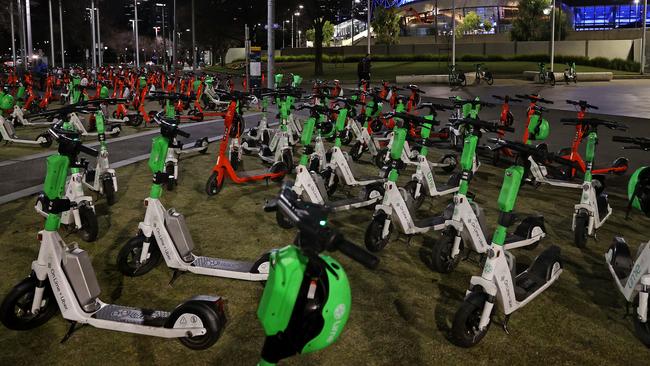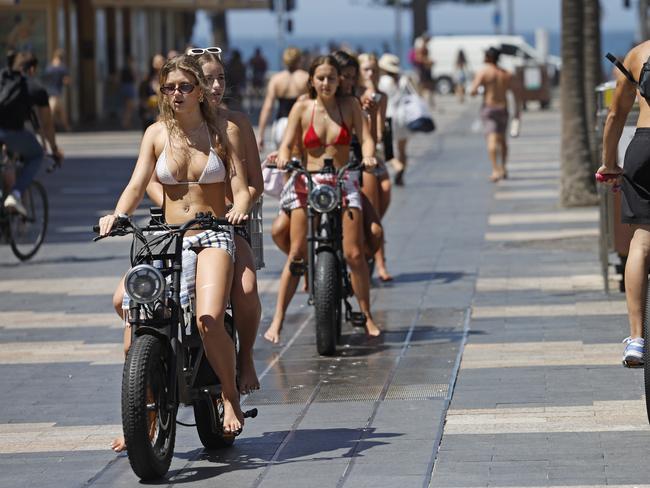Kylie Lang: Something needs to be done about the e-scooter, e-bike menaces on our streets
We have to have a serious conversation about e-scooters in Queensland after another tragedy, writes Kylie Lang.
Kylie Lang
Don't miss out on the headlines from Kylie Lang. Followed categories will be added to My News.
You have to wonder what it will take for the use of e-scooters to be properly scrutinised.
Trendy toys they are not. Tragically, they can be death traps.
Yesterday, another rider was killed on the Gold Coast.
As police investigations continue, another family is in mourning.
On paper, e-scooters make a degree of sense, but their application in real life can be disastrous.
Riders are dying or suffering catastrophic injuries, and hapless pedestrians are also at risk.
Last year alone, there were nearly 300 e-scooter crashes across Queensland – and eight deaths.
There have been 3305 serious injuries in the space of almost four years, according to the Queensland Injury Surveillance Unit.
And a study by emergency doctors at Royal Brisbane and Women’s Hospital reveals an average of two people a day are presenting for care after e-scooter accidents.
What’s more, the lithium batteries powering these devices can explode, with e-scooters now the main cause of admissions to RBWH’s burns unit.
Don’t even get me started on the eyesore of e-scooters cast aside on footpaths and in gutters.
Seriously folks, something needs to be done, and fast.
There are more e-scooters in circulation than ever before, thanks in part to last year’s $2m state government push for “e-mobility”.
The scheme offering $200 rebates for e-scooters and $500 for e-bikes closed in a matter of weeks, such was the uptake.

But as doctors and police officers have said, the then Labor government missed an opportunity by not combining the cash splash with e-mobility education and infrastructure upgrades.
Queensland also has some of the most lenient laws in Australia, with children over age 12 allowed to ride e-mobility devices under adult supervision and by themselves from age 16.
Market-bought devices can travel at a capped speed of 25km/h, but those that are modified or purchased from overseas can reach up to 90km/h.
And we’re putting them in the hands of kids? This is madness.
Older riders too – I know a 74-year-old who clipped a footpath and injured herself – are not safe.
Nor are pedestrians in the wrong place at the wrong time.

The speed limit for e-scooters on footpaths is 12km/h, 25km/h on bike paths, and 10km/h in shared zones.
Break the limit and face a fine of $161, the same as for failing to wear a helmet. Use a phone and you risk losing $1209.
Does anyone care?
In a single day in January this year, police fined 50 e-scooter and e-bike riders with 52 infringements for speeding or not wearing helmets.
Locations targeted on January 14 were the Goodwill, Kurilpa, Victoria and Kangaroo Point bridges, Howard Smith Wharves, New Farm Riverwalk and the Bicentennial Bikeway.
Imagine the number of fines if police had the resources to widen the scope. If the blitz was intended to be more than a revenue raiser and deter people from misusing e-scooters, it hasn’t worked.
One loyal reader of this column emailed me earlier this week to vent about the “crazy scooter scourge”.
“Walking around Brisbane has become hazardous, with riders going flat out, weaving in between people and not wearing helmets, and god knows what grog or drugs they had consumed,” he wrote.
“My wife and I were brushed by these riders and, I can tell you, if one of us had stepped sideways or turned suddenly, it would have been catastrophic.
“Police are nowhere to be seen.”
To be fair, police cannot be expected to nab every e-scooter ratbag. As we well know, they have more than enough to do already.
News this week that a three-wheel e-scooter – which won’t work without the rider wearing a helmet – is set to roll out on the Gold Coast later this year is welcome.
But it’s not enough.

Brisbane was the first major city in Australia to implement an e-scooter sharing (rental) scheme, in November 2018, and well over four million rides have been taken since.
Brisbane City Council says the benefits include accessibility, affordability and sustainability by theoretically reducing the number of cars on the road, cutting congestion and pollution.
This may be true, however, tighter regulations, better education and smarter technology are desperately needed because as it stands, e-scooters are disasters waiting to happen.
Kylie Lang is Associate Editor of The Courier-Mail
kylie.lang@news.com.au



